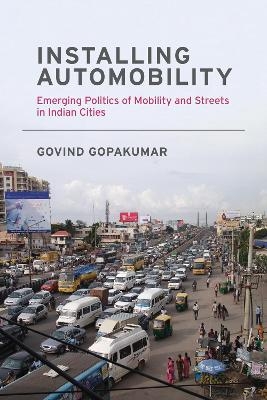
Installing Automobility
Emerging Politics of Mobility and Streets in Indian Cities
Seiten
2020
MIT Press (Verlag)
978-0-262-53891-6 (ISBN)
MIT Press (Verlag)
978-0-262-53891-6 (ISBN)
- Titel z.Zt. nicht lieferbar
- Versandkostenfrei
- Auch auf Rechnung
- Artikel merken
An examination of the process of prioritizing private motorized transportation in Bengaluru, a rapidly growing megacity of the Global South.
Automobiles and their associated infrastructures, deeply embedded in Western cities, have become a rapidly growing presence in the mega-cities of the Global South. Streets once crowded with pedestrians, pushcarts, vendors, and bicyclists are now choked with motor vehicles, many of them private automobiles. In this book, Govind Gopakumar examines this shift, analyzing the phenomenon of automobility in Bengaluru (formerly known as Bangalore), a rapidly growing city of about ten million people in southern India. He finds that the advent of automobility in Bengaluru has privileged the mobility needs of the elite while marginalizing those of the rest of the population.
Gopakumar connects Bengaluru's burgeoning automobility to the city's history and to the spatial, technological, and social interventions of a variety of urban actors. Automobility becomes a juggernaut, threatening to reorder the city to enhance automotive travel. He discusses the evolution of congestion and urban change in Bengaluru; the "regimes of congestion" that emerge to address the issue; an "infrastructurescape" that shapes the mobile behavior of all residents but is largely governed by the privileged; and the enfranchisement of an "automotive citizenship" (and the disenfranchisement of non-automobile-using publics). Gopakumar also finds that automobility in Bengaluru faces ongoing challenges from such diverse sources as waste flows, popular religiosity, and political leadership. These challenges, however, introduce messiness without upsetting automobility. He therefore calls for efforts to displace automobility that are grounded in reordering the mobility regime, relandscaping the city and its infrastructures, and reclaiming streets for other uses.
Automobiles and their associated infrastructures, deeply embedded in Western cities, have become a rapidly growing presence in the mega-cities of the Global South. Streets once crowded with pedestrians, pushcarts, vendors, and bicyclists are now choked with motor vehicles, many of them private automobiles. In this book, Govind Gopakumar examines this shift, analyzing the phenomenon of automobility in Bengaluru (formerly known as Bangalore), a rapidly growing city of about ten million people in southern India. He finds that the advent of automobility in Bengaluru has privileged the mobility needs of the elite while marginalizing those of the rest of the population.
Gopakumar connects Bengaluru's burgeoning automobility to the city's history and to the spatial, technological, and social interventions of a variety of urban actors. Automobility becomes a juggernaut, threatening to reorder the city to enhance automotive travel. He discusses the evolution of congestion and urban change in Bengaluru; the "regimes of congestion" that emerge to address the issue; an "infrastructurescape" that shapes the mobile behavior of all residents but is largely governed by the privileged; and the enfranchisement of an "automotive citizenship" (and the disenfranchisement of non-automobile-using publics). Gopakumar also finds that automobility in Bengaluru faces ongoing challenges from such diverse sources as waste flows, popular religiosity, and political leadership. These challenges, however, introduce messiness without upsetting automobility. He therefore calls for efforts to displace automobility that are grounded in reordering the mobility regime, relandscaping the city and its infrastructures, and reclaiming streets for other uses.
Govind Gopakumar is Chair and Associate Professor at the Centre for Engineering in Society at Concordia University, Montreal.
| Erscheinungsdatum | 15.04.2020 |
|---|---|
| Reihe/Serie | Urban and Industrial Environments |
| Zusatzinfo | 46 b&w illus.; 92 Illustrations |
| Sprache | englisch |
| Maße | 152 x 229 mm |
| Themenwelt | Natur / Technik ► Fahrzeuge / Flugzeuge / Schiffe ► Auto / Motorrad |
| Naturwissenschaften ► Geowissenschaften ► Geografie / Kartografie | |
| ISBN-10 | 0-262-53891-1 / 0262538911 |
| ISBN-13 | 978-0-262-53891-6 / 9780262538916 |
| Zustand | Neuware |
| Haben Sie eine Frage zum Produkt? |
Mehr entdecken
aus dem Bereich
aus dem Bereich


